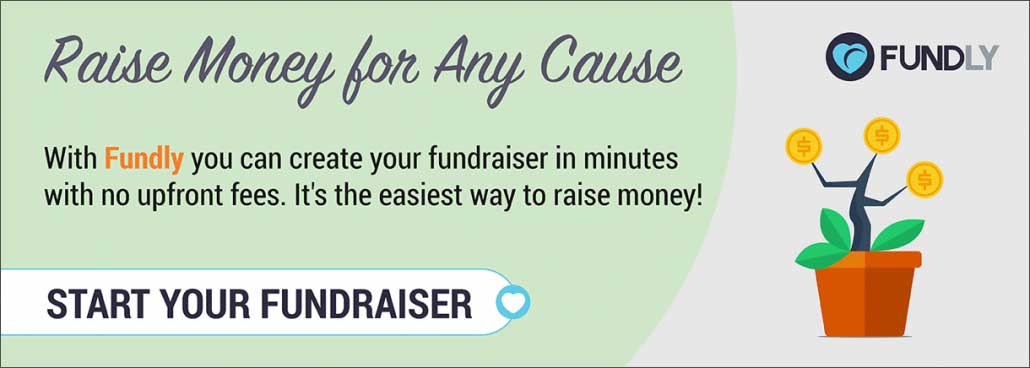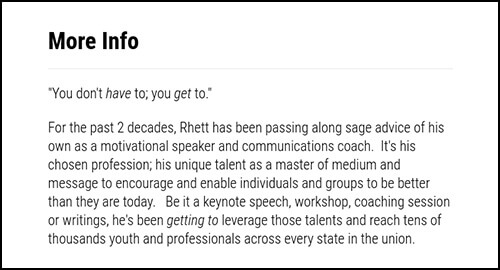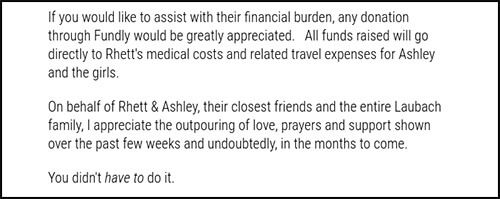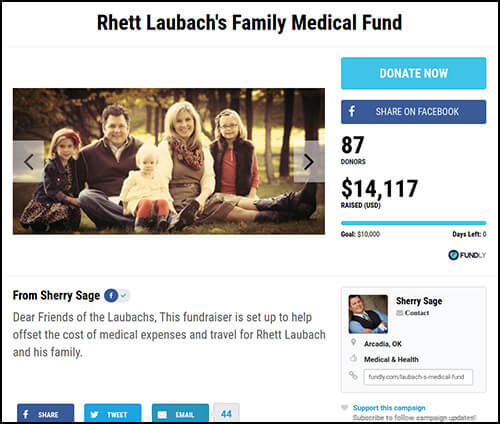Successful Crowdfunding Examples for Health and Medical Expenses
Crowdfunding is becoming an immensely popular way for organizations and individuals alike to raise money for health- and medical-related causes. Whether you’re trying to raise money for cancer awareness or to cover your expenses for an important surgery, you can start a campaign!
In fact, your cause has the potential to go viral and reach even more supporters. It’s not uncommon for crowdfunding campaigns to reach (or even exceed!) their fundraising goal in a short period.
Of course, a lot of preparation goes into running a successful campaign. And what better way to learn about reaching your goal than from an accomplished fundraiser?
We’ll look at the Rhett Laubach’s Family Medical Fund to show you the components that make a well thought-out crowdfunding campaign if you’re raising money for health- and medical-related causes.
Three factors play into a successful crowdfunding campaign:
Keep reading to learn more!
1. A compelling description
Potential donors will learn more about your campaign and why they should contribute through your crowdfunding description. Since there are so many different reasons to raise money for health- and medical-related causes, you need to be specific about why you’re raising funds.
Not only should you answer why you’re fundraising but also highlight the person you’re raising funds for. Generally, crowdfunding campaigns for health expenses are centered around the person undergoing medical treatment.
Crowdfunding description example:
The Rhett Laubach’s family fund was created after Rhett, a husband and father, was diagnosed with a meningioma brain tumor. The funds raised from this campaign helped support Rhett’s family and cover his medical expenses.
Take a look at the following example to see how this campaign’s description does quite a few things successfully:
First, the opening sentence immediately grabs readers’ attention. The first line, “You don’t have to; you get to” leaves donor curious for what that means. The next paragraph gives more background on Rhett’s personality, which connects donors to his cause and, hopefully, encourages them to donate.
After a few more paragraphs dedicated to Rhett’s character and situation, the author goes on to explain how the funds will be used:
The description is direct and specific, stating that those who want to show their support can do so by donating.
This description does a great job of explaining the cause — so much so that they were able to raise $14,117, exceeding their goal of $10,000!
Best practices to follow for your campaign:
Now that you understand why Rhett’s campaign was so successful, it’s time to see how you can use the same techniques.
Use the following best practices to create a captivating description:
- Hook your readers with an engaging first sentence. You can start your description with a quote or scene that helps illustrate your cause and the person you’re fundraising for.
- Focus on the person in need. While it’s important to explain the person’s medical situation, you should also use your description to highlight the individual’s accomplishments and personality. As these are the elements that will evoke your donors’ emotions.
- Explain how the funds will be used. Donors will expect to know how you plan to use the funds, and they’ll be more likely to give when you’re specific. Be direct with donors and let them know that their support will make an impact.
If you’re interested in learning more tips on how to write a crowdfunding description, check out this helpful resource.
2. Thoughtful images
An image is the first thing that your donors see when they encounter your crowdfunding page.
Plus, images add an engaging component to your campaign. Supporters can visualize the person and the life they’re supporting.
As such, it’s important that you not only include an image but also pick one that represents your health- or medical-related cause.
Crowdfunding photo example:
Let’s see how the Rhett Laubach campaign uses images to improve their crowdfunding page:
As soon as readers land on the page, they immediately see a picture of the Laubach family. Not only is the photo relevant to the cause, as the campaign was created to raise money for his wife and children while Rhett was unable to work, but it’s also a good quality image.
This is the first image that the author decided to show, but the arrows indicate that there are even more images donors can scroll through. Each photo is of Rhett and his family, connecting potential donors to the cause and speaking to their emotions.
Best practices to follow for your campaign:
As you can see, images help evoke donors’ emotions and connect them to the people the cause supports.
When you create your crowdfunding page, you should always include at least one photo to enhance your campaign and make it feel unique.
Here are a few best practices to consider when choosing which pictures to use:
- Order photos chronologically. You wouldn’t want to start a book by reading the end first. The same goes for your campaign images. If you’re raising money for health-related causes, create a cohesive timeline (with before and after images) so donors can see the complete story.
- Pick good quality images. You don’t need fancy equipment to make high-quality photos. Just make sure to take pictures with natural lighting and upload large photos.
- Find images that complement your description. This will help to illustrate the person’s character and provide reasons why donors should support your cause. For instance, since Rhett is a motivational speaker, the campaign creator added images of him at his speaking engagements.
- Post updates. During your campaign and even after, you can post updates on your progress. This best practice works especially well for health- and medical-related causes because donors will enjoy following your journey back to health.
Check out our crowdfunding photo tips for more expert advice on how to include images in your campaign.
3. Social sharing
What makes crowdfunding campaigns so successful is the social sharing element.
Think about it this way: if you create a crowdfunding page to fund your medical expenses and don’t share it, few people (other than your close family members and friends) would know about it.
By sharing your campaign online, you can reach a larger audience and have others share your cause with their networks.
Social sharing example:
Now that you understand why social sharing is vital to your campaign, let’s look at how Rhett Laubach’s campaign shared their crowdfunding page.
Here is an example of how Rhett’s brother shared the campaign on Facebook:
This Facebook post is successful for many reasons:
- It was posted at an opportune time. This post was made on Rhett’s birthday, asking supporters to contribute as a present.
- The post links to the crowdfunding page. Interested donors can easily contribute or share the link with their peers.
- It uses a condensed version of the crowdfunding description. The post starts with information about why the campaign was started and how the funds will be used.
The post was so successful in eliciting support that 50 people shared this post, which means that even more supporters were inspired to donate to the cause.
Best practices for social sharing:
Social sharing is the focal point of any successful campaign. Without it, fewer people would know about your cause, which would make it difficult to reach your goal.
The trick is to post inspiring updates and tweets to encourage your followers to contribute.
Keep the following tips in mind when you share your crowdfunding page:
- Post on multiple channels. Use the channels you’re active on so that you can reach the most people possible.
- Post frequently (but not too much). Post once a week and at opportune times (i.e. the day before the end of your campaign). That way, donors remember your cause.
- Link to your campaign. This may seem like common sense, but linking to your campaign will make it easier for donors to reach your fundraising page and contribute. Don’t forget this crucial step!
If you want more information on sharing your crowdfunding campaign, check out our social media templates for Facebook, Twitter, and Instagram.
The Rhett Laubach’s Family Medical Fund used these three tools to improve their campaign, and they managed to exceed their goal!
And the best part is so can you! If you’re raising funds for healthcare causes or medical expenses, you can follow these best practices to reach your campaign goals.
Looking for more crowdfunding advice? We’ve got additional resources for you to check out:
- Crowdfunding 101. Don’t start your campaign without first learning the basics. This guide will teach you everything about online fundraising for your cause.
- How to Ask for Donations. Soliciting donations can be intimidating especially if you don’t have any experience. This guide will take you through the steps so you can become a pro.
- How to Write Crowdfunding Updates. Even after you’ve reach your goal, it’s important to keep donors updated on how the funds are being used. Get five tips on how to keep your supporters in the loop.












